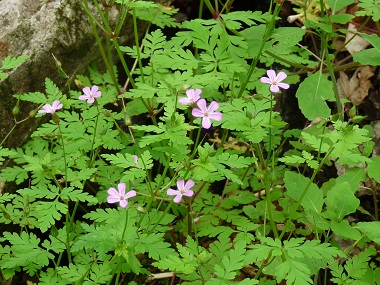



To support our efforts please browse our store (books with health benefits, etc.).
Herb Robert, or what was once known as Saint Robert's Herb, was named after a French monk who lived in 1000 AD, who has cured many people suffering from various diseases using this plant. First Nations people have used this plant internally to help with many health ailments and externally for healing wounds, herpes and skin eruptions. According to an article in The Healing Journal, scientists, herbalists, and botanists have discovered that Herb Robert grows especially abundant in areas that have high radiation levels (which include under hydro lines). It is believed that Herb Robert absorbs the radiation from the soil, breaks it down and disperses it.
Distinguishing Features
Herb Robert is a ubiquitous sprawling plant well-known for its unpleasant smell and its vibrant bright pink flowers. This plant flowers from spring all the way into October if the weather conditions are good.
Flowers
Herb Robert flowers is actinomorphic (meaning it is a radial or star-shaped flower). It measures 1.5 to 2 cm (0.6–0.8”) across. Herb Robert has five petals, is usually a dark rose-red, with paler veins, and round-tipped. (Sometimes the flower is pale pink.) It has five sepals with broadly membranous margins, is glossy, long-haired, and erect. This flower has ten stamens and the pistil has five carpels. Flowers usually grow axillary in pairs or terminating stems. Herb Robert blooms anywhere from late spring into early autumn depending on location.
 Fields
of Nutrition has medicinal benefits and vitamin/mineral content of Herb Robert.
Fields
of Nutrition has medicinal benefits and vitamin/mineral content of Herb Robert.
Leaves
Dark green leaves are palmately divided, about 6 cm long, with light green, purple-edged leaflets. If Herb Robert leaves are picked regularly, this plant will produce a bounty of leaves so long as the growing conditions permit it.
Height
Average height of this plant is between 30 and 40 cm.
Habitat
Moist shady positions in undergrowth, rocks and walls, hedge banks, and waste places. It grows best in shady areas.
Edible Parts
Fresh leaves can be eaten or tossed into a mug to make a tea. The flower and leaves can be dried and stored so that it can be used throughout the winter months as a tea or tossed into salads as a nutrient booster. The root can be dried and used. Rubbing fresh leaves on the skin is said to repel mosquitoes, and the entire plant repels rabbits and deer.
Other Name
Bloodwort.
Similar Plants
Geranium.
Winter Survival Food Handbook

PDF Plant Magazines
Types of Wild Food
Geographic Zones Seasons
Disclaimer
EdibleWildFood.com is informational in nature. While we strive to be 100% accurate, it is solely up to the reader to ensure proper plant identification. Some wild plants are poisonous or can have serious adverse health effects.
We are not health professionals, medical doctors, nor are we nutritionists. It is up to the reader to verify nutritional information and health benefits with qualified professionals for all edible plants listed in this web site. Please click here for more information.
Why Edible Wild Food?
- Food costs are rising
- Free, wild food is readily abundant
- Wild food adds nutrition to your diet
- Wild food can help treat various medical conditions







